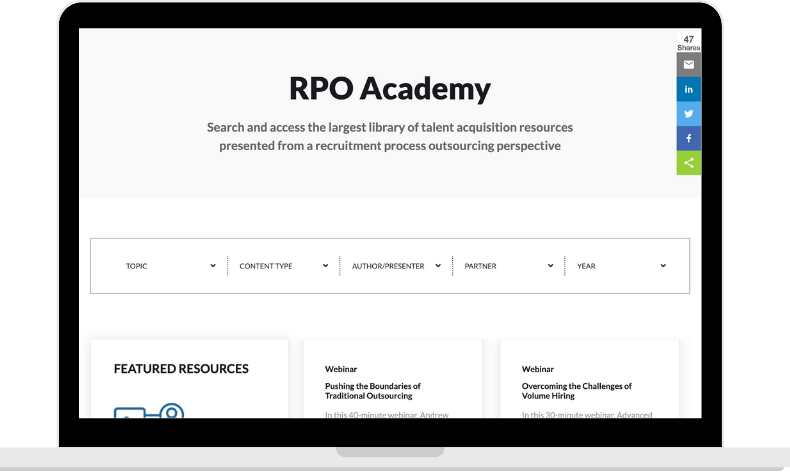-min.jpg?width=800&height=533&name=iStock-1720679909%20(1)-min.jpg)
A candid chat with a CFO sparked Maria Scarangella's mission to change talent acquisition at GEICO. After discovering significant HR allocations in her $2.5 billion P&L, Scarangella called the CFO to question the value. His response changed her perspective on strategic partnership forever: "Either figure out how to use it or accept it."
This exchange prefigures the disconnect many RPO leaders face today. They offer important recruitment services, but they often find it hard to show their strategic value beyond just filling jobs. This gap creates an opportunity for RPO providers to shift from vendors into true strategic partners.
At the 2024 Annual RPOA Conference, Scarangella, President of Scarangella Consulting LLC, urged RPO leaders to show their strategic value. She emphasized the need to do more than just hire. Below, we provided a recap of her presentation.
CEO Priorities and Business Challenges
"We need to become strategic business partners and drive end business results," Scarangella said. PwC's study of 500 CEOs revealed a clear priority. "Ninety-five percent gave the same answer: innovation," Scarangella noted. "They may not know exactly what they want, but their organizations must move forward."
Talent drives innovation and strategic partnerships. PwC's employee survey at these organizations uncovered key barriers. "People didn't know who held responsibility. The company lacked a good plan. No one had time to innovate," Scarangella explained.
Strategic partners create a measurable effect by connecting people, data, and technology. Scarangella said, "Accenture promised an 8 to 10 percent boost with services and technology." They saw an 11 percent increase on the bottom line after adding the people component. No organization will reject an 11 percent increase to their bottom line."
Scarangella next presented a strategic framework. This tool shows RPO leaders how to understand CEO priorities and find a way to achieve their goals.
Strategic Framework for RPO Leaders
"For any customer you work with, you should know their organization's two main goals," Scarangella said. "What's the CEO's bonus based on? It's EBITDA and revenue growth." She emphasized that these metrics remain consistent across organizations.
Understanding employee lifecycle costs shapes how organizations achieve these goals. At GEICO, Scarangella's team measured specific cost points throughout the talent journey. "Our cost per hire when we first started was about $1,200 per person," she said, referring to customer service representatives.
The cost impact grows significantly with early departures. "Our cost of turnover for that same person was $40,000," Scarangella explained.
Her team identified clear patterns:
- Losing someone within three months led to a total investment loss.
- Departures at six months caused a 50 percent drop in performance from months three to six.
- Leaving after one year resulted in a cost of $54,000.
Four-year departures had high opportunity costs. Replacements took six months to provide real value.
Performance Quartiles Drive Strategic Value
Understanding cost variations extends beyond hiring and turnover. Scarangella's analysis revealed substantial performance differences across employee quartiles. "Think about the cost difference between a good performer, an average one, and a poor one," she said. In sales roles, her team identified distinct performance patterns across four quartiles. The top quartile, which she called 'rabbits,' consistently drove innovation and found creative solutions. Second-quartile performers showed potential for advancement with insights from the 'rabbits.' Employees in the third quartile needed a lot of development investment. Yet, those in the fourth quartile showed low returns from such efforts.
This quartile analysis transformed how GEICO approached talent investment. Scarangella's team calculated the revenue difference between quartiles. They found that raising second-quartile performers to first-quartile and third-quartile performers to second-quartile could boost performance by 25 percent. This could be done without increasing salary costs. This insight changed HR talks. Instead of focusing on time-to-hire, they now emphasize business outcomes that matter to C-suite leaders.
RPO leaders who grasp performance quartiles can adjust hiring strategies. They can aim for candidates with top-tier potential. This change transforms basic recruitment into effective talent optimization.
Scarangella also noted that when communicating hiring priorities to executives, recruiters should focus on business impact rather than just operational metrics.
Listen to Maria's 2024 RPOA Annual Conference keynote on the Time to Hire Podcast.
Building Strategic Value
Scarangella used her knowledge of downstream hiring costs to track expenses throughout the employee lifecycle. She looked at costs from applications, hiring, onboarding, training, and development. This data drove a unique budget proposal to Warren Buffett, who owns GEICO, which is a wholly owned subsidiary of Berkshire Hathaway. "I'm not asking for a budget," she told Buffett at the annual senior leadership presentation. "I want half of the savings I deliver to reinvest in valuable programs, and the rest can go back to the organization."
Buffett responded, "You're either crazy, stupid, or have a good idea," he said, "and we've got nothing to lose by trying what you want to do." The company approved her variable budget model based on delivered savings.
The approach generated $94 million in yearly savings. Her team cut hiring costs by $3.6 million, reduced training expenses by $54 million, and decreased turnover costs by $37 million.
"The key part is being able to speak the language of business," Scarangella said. "When you use terms that resonate with senior leadership, you become much more effective." Her work with SHRM showed that many HR professionals struggle to name key metrics. These include cost per hire, cost per application, cost of turnover, and cost of onboarding. In today's efficiency-focused market, HR leaders must understand these numbers to engage with CFOs. "You either help organizations become more efficient at selling their services, or you make their job harder." Scarangella pointed out the next challenge for RPO leaders. They need to set their partnership apart from traditional vendor relationships.
Differentiation Strategy
Strategic RPO partners differentiate themselves through rigorous performance standards. "Unless you can give me a 10x return on investment, I don't want to take the chance and pilot it," Scarangella said. This need shaped how GEICO evaluated potential partnerships.
Multi-year contracts emerged from proven value delivery. Scarangella explained how her team typically selected from three or four vendors for initial work. The partner delivering the most value earned long-term contracts. "It's time consuming to go through that process," she said. "You want to work with someone you trust."
This selective approach extends beyond basic automation. "RPO is the perfect solution because you have the flexibility," Scarangella said. She noted that during staff reductions, organizations often cut internal recruiters first. Strategic partners like RPO provide stability through these transitions.
"You want to be part of the conversation and partner with your clients so they rely upon you," Scarangella explained. "When it comes to a talent decision, you should be the first one they call because you give them value beyond just filling a slot."
These differentiation strategies bring quick value. But Scarangella said RPO leaders must also prepare for challenges ahead.
Future-Proofing the Partnership
As automation reshapes recruitment, strategic partners must change. "The world is changing quickly, and if everything's being automated, where's the additional value?" Scarangella asked. "The additional value is in strategy, in alignment, and in helping them make better decisions for their organization."
This shift requires thinking differently about client interaction. Strategic partners help clients understand costs at every stage of the employee lifecycle. This leads to smarter spending strategies. They create pilots with clear metrics, establish starting points, and track value delivery.
Most importantly, they maintain flexibility. When organizations cut staff, RPO providers can help. They provide solutions that spare leaders from the tough decisions of layoffs. This adaptability, combined with strategic insight, makes them invaluable partners.
RPO leaders must look past old metrics. They need to show real business effectiveness to form strategic partnerships. RPO providers can be key partners in their clients' success. They do this by knowing client goals, tracking key data, and showing clear value. The future belongs to those who help organizations make better talent decisions—not fill positions.
We invite you to elevate your RPO value proposition-sign up for Maria's HR Economics Certificate Program today!














